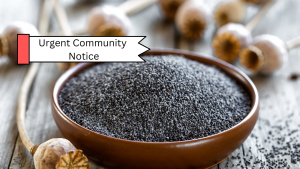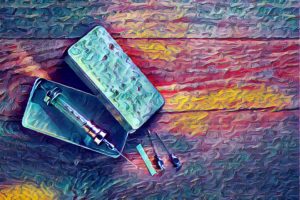
Community notice – contaminated poppy seeds causing severe negative reactions
Several cases of severe toxicity after consuming poppy seed tea have recently presented to various hospitals in southeast Queensland, New…
This is my personal account with Golden Staph, written in hopes of informing others and providing advice on avoiding this very serious infection.
I identify as a person who uses drugs and have had a long history with a variety of substances. I started as many do, smoking cannabis at a young age, before moving on to party drugs like MDMA and speed. Finally, at around the age of 24, I started experimenting with heroin and methylamphetamine before developing a ‘habit’ to heroin and injecting daily. When this became unmanageable, I turned to opiate maintenance therapy which I remain on to this day. I still occasionally use heroin and methylamphetamine and use benzos on occasion however I have been somewhat successful in stabilizing my use, no longer injecting daily.
This change in my use was in large part due to my experience with Golden Staph which was in equal parts worrying and disruptive to my lifestyle and health. It is impossible to identify the exact injection that introduced the infection to my bloodstream but I can point to a time in my use where I was not doing the correct things needed to avoid infection or “shooting clean”. I can however, pinpoint the day in which I had onset of symptoms and know that this was after I period of “binging” on various drugs.
Benzos played a role in this by decreasing my want to care for my body. Methamphetamine likely also played a role by lowering my immunity and allowing my “binging” to continue beyond the normal period in which I would need to sleep, allowing for more injections. During this period I remember having problems finding a vein which led to repeated injections with the same needle. This blunts the needles which causes excess injury to veins which makes it easier for infections to reach the bloodstream. Additionally, I remember dropping my needle on a number of occasions at a house of a person who’s partner had recently passed from complications associated with Staph. I have since learnt that an estimated 20%-30% of people are life-long carriers of Staphylococcus aureus meaning it is quite common in the population.
After I woke from sleeping off this period of “binging” I noticed that I had a mild to moderate fever and flu like symptoms. These symptoms were in no way debilitating and I did not think too much off them at the time, thinking that I may have some mild flu or infection. Luckily, I have a close relative who immediately recognized that this may be something more serious and she advised me to attend the hospital right away.
This advice may have saved my life, as the infection was identified at almost the earliest possible moment before it had a chance to fully colonize my body and cause all sorts of complications. Upon arriving to the hospital and learning I am an injecting drug user, the doctors immediately did blood tests and discovered the Staph infection. The doctors made it very clear that this was a life-threatening condition and I would be in hospital for a minimum of a few weeks receiving I.V. anti-biotics. They told me that the worst outcome would be that the Staph colonized my heart causing Endocarditis or an infection of the inner lining of the heart. This can result in complications to the heart which are often deadly. Obviously, this was an extremely scary point in my life, made worse by the isolation from friends and family while I was in hospital. Luckily, upon receiving the first batches of anti-biotics, blood tests were negative for Staph. However, the doctors informed me that it could return and I would need to remain in hospital getting daily blood tests and I.V. antibiotics.
This leads me to perhaps the most traumatic period of my life. Due to my drug use causing damage to my veins, probable dehydration and the large needles needed in the treatment regime it was extremely difficult for the health workers to get a vein. I needed a new catheter line everyday for my antibiotics which meant multiple attempts and multiple painful needle insertions. Sometimes this would be upwards of 5 attempts until a successful line was put in. This felt humiliating, as well as extremely painful. It also caused a lot of damage to veins throughout my time in hospital.
After a few weeks at the hospital, the option to transfer to home care was put forward. This would mean that I could go home with an antibiotic pump, returning to the hospital daily to have it refilled and a new catheter put in. However, some of the doctors resisted this option sighting the risk of me using the catheter at home to inject illegal drugs which would put me at further risk of infection. To me this felt like simple stigma towards me as a drug user. Simple because I injected drug users there was a chance I would be denied a more comfortable form of treatment and put through an additional period of 2 weeks in hospital. This was only resolved by some strong advocacy on my, my family and my doctors part. In the end I was allowed to go home with the anti-biotic pump and I had no further complications in eliminating the infection.
I learnt valuable life lessons from this difficult experience with Staph. Firstly, I ALWAYS use clean, new injecting equipment and practice safe shooting procedures at all times.
It is easy to become complacent and lazy when it comes to injecting daily but your health is simply too important to be put at risk. Please see the below step by step instructions on how I prepare and inject safely and hygienically. Secondly, stigma around drug use certainly can extend into medical settings. I have no doubt that the doctors thought they were “protecting me from myself” by denying me treatment at home however this felt hurtful and demeaning. Just because I inject drugs does not mean I do not value my own health!
• Never share any equipment, including the mix, water, swabs, filters, tourniquets, needle, syringe, etc.
• Always use new and clean equipment for each hit. Sterile syringes are available from pharmacies, vending machines and your local Needle and Syringe Program. Please see the following link for your local providers.
https://directory.atoda.org.au/category/service-type/needle-syringe-program/
• Wash your hands thoroughly before and after injecting. Swab the spot your injecting with an alcohol swab in one direction, not in a circular repeated motion which may just move bacteria around.
• Don’t help others or let them help you unless hands have been washed – and even then there is no absolute guarantee that it will stop infection. Similarly, if a tourniquet is required, do not share as there may be blood from the other person still present.
• Wash and clean the area being used to mix and prepare (e.g. table).
• Never re-cap a syringe unless it’s your own. Never bend the needle/syringe.
• Dispose of used equipment in disposal containers (fitpacks and sharp bins) which are available from your local Needle and Syringe Program and some pharmacies.
Written by Anonymous

Several cases of severe toxicity after consuming poppy seed tea have recently presented to various hospitals in southeast Queensland, New…

My name is John, and I would like to talk about some of my drug using experiences and how I…

About Piperazines Piperazine derivatives (also called piperazines) are a class of drugs which are related to piperazine, a chemical used…